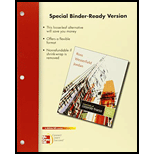
To determine: The expected return of Stock A and Stock B.
Introduction:
Expected return refers to the return that the investors expect on a risky investment in the future
Answer to Problem 7QP
The expected return of Stock A is 0.103 or 10.3% and the expected return of Stock B is 0.147 or 14.7%.
Explanation of Solution
Given information:
Stock A’s
Stock B’s rate of return is −30 percent when the economy is in a recession, 18 percent when the economy is normal, and 31 percent when the economy is in a boom.
The probability of having a recession is 0.15, the probability of having a normal economy is 0.55, and the probability of having a booming economy is 0.30.
The formula to calculate the expected return on the stock:
Where,
R1 refers to the rate of returns during the recession economy,
Rn refers to the rate of returns for “n” number of items,
P1 refers to the probability of having a recession economy,
Pn refers to the probability of having “n” number of economy.
Compute the expected return on Stock A:
Hence, the expected return on Stock A is 0.103 or 10.3%.
Compute the expected return on Stock B:
Hence, the expected return on Stock B is 0.147 or 14.7%.
To determine: The standard deviation of Stock A and Stock B.
Introduction:
Standard deviation refers to the variation in the actual returns from the expected returns.
Answer to Problem 7QP
The standard deviation of Stock A is 4.124% and the standard deviation of Stock B is 17.65%.
Explanation of Solution
Given information:
Stock A’s rate of return is 2 percent when the economy is in a recession, 10 percent when the economy is normal, and 15 percent when the economy is in a boom.
Stock B’s rate of return is −30 percent when the economy is in a recession, 18 percent when the economy is normal, and 31 percent when the economy is in a boom.
The probability of having a recession is 0.15, the probability of having a normal economy is 0.55, and the probability of having a booming economy is 0.30.
The formula to calculate the standard deviation of the stock:
Compute the standard deviation of Stock A:
Hence, the standard deviation of Stock A is 4.124%.
Compute the standard deviation of Stock B:
Hence, the standard deviation of Stock B is 17.65%.
Want to see more full solutions like this?
Chapter 11 Solutions
ESSENTIAL OF CORP FINANCE W/CONNECT
- Take value of 1.01^-36=0.699 . step by steparrow_forwardsolve this question.Pat and Chris have identical interest-bearing bank accounts that pay them $15 interest per year. Pat leaves the $15 in the account each year, while Chris takes the $15 home to a jar and never spends any of it. After five years, who has more money?arrow_forwardWhat is corporate finance? explain all thingsarrow_forward
 Essentials Of InvestmentsFinanceISBN:9781260013924Author:Bodie, Zvi, Kane, Alex, MARCUS, Alan J.Publisher:Mcgraw-hill Education,
Essentials Of InvestmentsFinanceISBN:9781260013924Author:Bodie, Zvi, Kane, Alex, MARCUS, Alan J.Publisher:Mcgraw-hill Education,

 Foundations Of FinanceFinanceISBN:9780134897264Author:KEOWN, Arthur J., Martin, John D., PETTY, J. WilliamPublisher:Pearson,
Foundations Of FinanceFinanceISBN:9780134897264Author:KEOWN, Arthur J., Martin, John D., PETTY, J. WilliamPublisher:Pearson, Fundamentals of Financial Management (MindTap Cou...FinanceISBN:9781337395250Author:Eugene F. Brigham, Joel F. HoustonPublisher:Cengage Learning
Fundamentals of Financial Management (MindTap Cou...FinanceISBN:9781337395250Author:Eugene F. Brigham, Joel F. HoustonPublisher:Cengage Learning Corporate Finance (The Mcgraw-hill/Irwin Series i...FinanceISBN:9780077861759Author:Stephen A. Ross Franco Modigliani Professor of Financial Economics Professor, Randolph W Westerfield Robert R. Dockson Deans Chair in Bus. Admin., Jeffrey Jaffe, Bradford D Jordan ProfessorPublisher:McGraw-Hill Education
Corporate Finance (The Mcgraw-hill/Irwin Series i...FinanceISBN:9780077861759Author:Stephen A. Ross Franco Modigliani Professor of Financial Economics Professor, Randolph W Westerfield Robert R. Dockson Deans Chair in Bus. Admin., Jeffrey Jaffe, Bradford D Jordan ProfessorPublisher:McGraw-Hill Education





